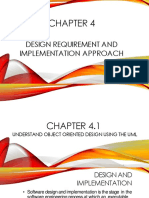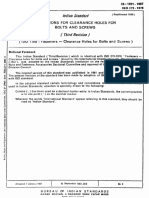0 ratings0% found this document useful (0 votes)
8 viewsCh7 Design and Implementation Object Oriented Design Using UML
Uploaded by
nireekshashetty.putturCopyright
© © All Rights Reserved
Available Formats
Download as PPTX, PDF, TXT or read online on Scribd
0 ratings0% found this document useful (0 votes)
8 viewsCh7 Design and Implementation Object Oriented Design Using UML
Uploaded by
nireekshashetty.putturCopyright
© © All Rights Reserved
Available Formats
Download as PPTX, PDF, TXT or read online on Scribd
You are on page 1/ 29
Chapter 7 – Design and Implementation
30/10/2014 Chapter 7 Design and Implementation 1
Object oriented Design using
UML.
Topics covered
• Object-oriented design using the UML
30/10/2014 Chapter 7 Design and Implementation 3
Design and implementation
• Software design and implementation is the stage in the software
engineering process at which an executable software system is
developed.
• Software design and implementation activities are invariably inter-
leaved.
• Software design is a creative activity in which you identify software
components and their relationships, based on a customer’s requirements.
• Implementation is the process of realizing the design as a program.
30/10/2014 Chapter 7 Design and Implementation 4
Build or buy
• In a wide range of domains, it is now possible to buy off-the-shelf
systems (COTS) that can be adapted and tailored to the users’
requirements.
• For example, if you want to implement a medical records system, you can
buy a package that is already used in hospitals. It can be cheaper and faster to
use this approach rather than developing a system in a conventional
programming language.
• When you develop an application in this way, the design process
becomes concerned with how to use the configuration features of
that system to deliver the system requirements.
30/10/2014 Chapter 7 Design and Implementation 5
Object-oriented design using the UML
30/10/2014 Chapter 7 Design and Implementation 6
An object-oriented design process
• Structured object-oriented design processes involve developing a
number of different system models.
• They require a lot of effort for development and maintenance of
these models and, for small systems, this may not be cost-effective.
• However, for large systems developed by different groups design
models are an important communication mechanism.
30/10/2014 Chapter 7 Design and Implementation 7
Process stages
• There are a variety of different object-oriented design processes that
depend on the organization using the process.
• Common activities in these processes include:
• Define the context and modes of use of the system;
• Design the system architecture;
• Identify the principal system objects;
• Develop design models;
• Specify object interfaces.
• Process illustrated here using a design for a wilderness weather
station.
30/10/2014 Chapter 7 Design and Implementation 8
System context and interactions
• Understanding the relationships between the software that is being
designed and its external environment is essential for deciding how
to provide the required system functionality and how to structure
the system to communicate with its environment.
• Understanding of the context also lets you establish the boundaries
of the system. Setting the system boundaries helps you decide what
features are implemented in the system being designed and what
features are in other associated systems.
30/10/2014 Chapter 7 Design and Implementation 9
Context and interaction models
• A system context model is a structural model that demonstrates the
other systems in the environment of the system being developed.
• An interaction model is a dynamic model that shows how the system
interacts with its environment as it is used.
30/10/2014 Chapter 7 Design and Implementation 10
System context for the weather station
30/10/2014 Chapter 7 Design and Implementation 11
Weather station use cases
30/10/2014 Chapter 7 Design and Implementation 12
Use case description—Report weather
System Weather station
Use case Report weather
Actors Weather information system, Weather station
Description The weather station sends a summary of the weather data that has been
collected from the instruments in the collection period to the weather
information system. The data sent are the maximum, minimum, and average
ground and air temperatures; the maximum, minimum, and average air
pressures; the maximum, minimum, and average wind speeds; the total
rainfall; and the wind direction as sampled at five-minute intervals.
Stimulus The weather information system establishes a satellite communication link
with the weather station and requests transmission of the data.
Response The summarized data is sent to the weather information system.
Comments Weather stations are usually asked to report once per hour but this frequency
may differ from one station to another and may be modified in the future.
30/10/2014 Chapter 7 Design and Implementation 13
Architectural design
• Once interactions between the system and its environment have been
understood, you use this information for designing the system architecture.
• You identify the major components that make up the system and
their interactions, and then may organize the components using an
architectural pattern such as a layered or client-server model.
• The weather station is composed of independent subsystems that
communicate by broadcasting messages on a common infrastructure.
30/10/2014 Chapter 7 Design and Implementation 14
High-level architecture of the weather station
30/10/2014 Chapter 7 Design and Implementation 15
Architecture of data collection system
30/10/2014 Chapter 7 Design and Implementation 16
Object class identification
• Identifying object classes is often a difficult part of object oriented
design.
• There is no 'magic formula' for object identification. It relies on the
skill, experience and domain knowledge of system designers.
• Object identification is an iterative process. You are unlikely to get it
right first time.
30/10/2014 Chapter 7 Design and Implementation 17
Approaches to identification
• Use a grammatical approach based on a natural language description of the
system.
• Base the identification on tangible things in the application domain.
• Use a behavioural approach and identify objects based on what participates in
what behaviour.
• Use a scenario-based analysis. The objects, attributes and methods in each
scenario are identified.
30/10/2014 Chapter 7 Design and Implementation 18
Weather station object classes
• Object class identification in the weather station system may be based on the
tangible hardware and data in the system:
• Ground thermometer, Anemometer, Barometer
• Application domain objects that are ‘hardware’ objects related to the instruments in the system.
• Weather station
• The basic interface of the weather station to its environment. It therefore reflects the interactions
identified in the use-case model.
• Weather data
• Encapsulates the summarized data from the instruments.
30/10/2014 Chapter 7 Design and Implementation 19
Weather station object classes
30/10/2014 Chapter 7 Design and Implementation 20
Design models
• Design models show the objects and object classes and relationships
between these entities.
• There are two kinds of design model:
• Structural models describe the static structure of the system in terms of
object classes and relationships.
• Dynamic models describe the dynamic interactions between objects.
30/10/2014 Chapter 7 Design and Implementation 21
Examples of design models
• Subsystem models that show logical groupings of objects into coherent
subsystems.
• Sequence models that show the sequence of object interactions.
• State machine models that show how individual objects change their state in
response to events.
• Other models include use-case models, aggregation models, generalisation
models, etc.
30/10/2014 Chapter 7 Design and Implementation 22
Subsystem models
• Shows how the design is organised into logically related groups of
objects.
• In the UML, these are shown using packages - an encapsulation
construct. This is a logical model. The actual organisation of objects
in the system may be different.
30/10/2014 Chapter 7 Design and Implementation 23
Sequence models
• Sequence models show the sequence of object interactions that take
place
• Objects are arranged horizontally across the top;
• Time is represented vertically so models are read top to bottom;
• Interactions are represented by labelled arrows, Different styles of arrow
represent different types of interaction;
• A thin rectangle in an object lifeline represents the time when the object is
the controlling object in the system.
30/10/2014 Chapter 7 Design and Implementation 24
Sequence diagram describing data collection
30/10/2014 Chapter 7 Design and Implementation 25
State diagrams
• State diagrams are used to show how objects respond to different service
requests and the state transitions triggered by these requests.
• State diagrams are useful high-level models of a system or an object’s
run-time behavior.
• You don’t usually need a state diagram for all of the objects in the
system. Many of the objects in a system are relatively simple and a
state model adds unnecessary detail to the design.
30/10/2014 Chapter 7 Design and Implementation 26
Weather station state diagram
30/10/2014 Chapter 7 Design and Implementation 27
Interface specification
• Object interfaces have to be specified so that the objects and other components
can be designed in parallel.
• Designers should avoid designing the interface representation but should hide
this in the object itself.
• Objects may have several interfaces which are viewpoints on the methods
provided.
• The UML uses class diagrams for interface specification but Java may also be
used.
30/10/2014 Chapter 7 Design and Implementation 28
Weather station interfaces
30/10/2014 Chapter 7 Design and Implementation 29
You might also like
- MSC Computer Science With Data AnalyticsNo ratings yetMSC Computer Science With Data Analytics23 pages
- Ch7 - Design and Implementation - 10th Edition (1) 1No ratings yetCh7 - Design and Implementation - 10th Edition (1) 156 pages
- Lecture 1: Chapter 7 - Design and ImplementationNo ratings yetLecture 1: Chapter 7 - Design and Implementation56 pages
- Software Engineering - Chapter 7 - Detail Design - 1004486No ratings yetSoftware Engineering - Chapter 7 - Detail Design - 100448637 pages
- Chapter 4.1 Understand Object Oriented Design Using UMLNo ratings yetChapter 4.1 Understand Object Oriented Design Using UML30 pages
- Ch7 Design and Implementation - Lecture 10 - 12No ratings yetCh7 Design and Implementation - Lecture 10 - 1249 pages
- Software Engineering Lectures After MidNo ratings yetSoftware Engineering Lectures After Mid46 pages
- 22-Object Oriented Design, UID-15!03!2024No ratings yet22-Object Oriented Design, UID-15!03!202413 pages
- Mastering OpenTelemetry: Building Scalable Observability Systems for Cloud-Native ApplicationsFrom EverandMastering OpenTelemetry: Building Scalable Observability Systems for Cloud-Native ApplicationsNo ratings yet
- Model-Driven Online Capacity Management for Component-Based Software SystemsFrom EverandModel-Driven Online Capacity Management for Component-Based Software SystemsNo ratings yet
- Smart Grid Challenges and OpportunitiesNo ratings yetSmart Grid Challenges and Opportunities18 pages
- User Instructions For Parallel Processing With Opendss-Pm: Davis Montenegro Roger Dugan Revised 06-20-2019No ratings yetUser Instructions For Parallel Processing With Opendss-Pm: Davis Montenegro Roger Dugan Revised 06-20-20199 pages
- HUAWEI SMU02B Monitoring Unit Data Sheet PDF100% (1)HUAWEI SMU02B Monitoring Unit Data Sheet PDF2 pages
- Fire Protection System - Lab 4 - StudentNo ratings yetFire Protection System - Lab 4 - Student9 pages
- Vermona ER9 MIDI Interface: User and Installation GuideNo ratings yetVermona ER9 MIDI Interface: User and Installation Guide18 pages
- Ch7 - Design and Implementation - 10th Edition (1) 1Ch7 - Design and Implementation - 10th Edition (1) 1
- Software Engineering - Chapter 7 - Detail Design - 1004486Software Engineering - Chapter 7 - Detail Design - 1004486
- Chapter 4.1 Understand Object Oriented Design Using UMLChapter 4.1 Understand Object Oriented Design Using UML
- Mastering OpenTelemetry: Building Scalable Observability Systems for Cloud-Native ApplicationsFrom EverandMastering OpenTelemetry: Building Scalable Observability Systems for Cloud-Native Applications
- Model-Driven Online Capacity Management for Component-Based Software SystemsFrom EverandModel-Driven Online Capacity Management for Component-Based Software Systems
- Visualised Systems Engineering on Railway ProjectsFrom EverandVisualised Systems Engineering on Railway Projects
- User Instructions For Parallel Processing With Opendss-Pm: Davis Montenegro Roger Dugan Revised 06-20-2019User Instructions For Parallel Processing With Opendss-Pm: Davis Montenegro Roger Dugan Revised 06-20-2019
- Vermona ER9 MIDI Interface: User and Installation GuideVermona ER9 MIDI Interface: User and Installation Guide
























































































